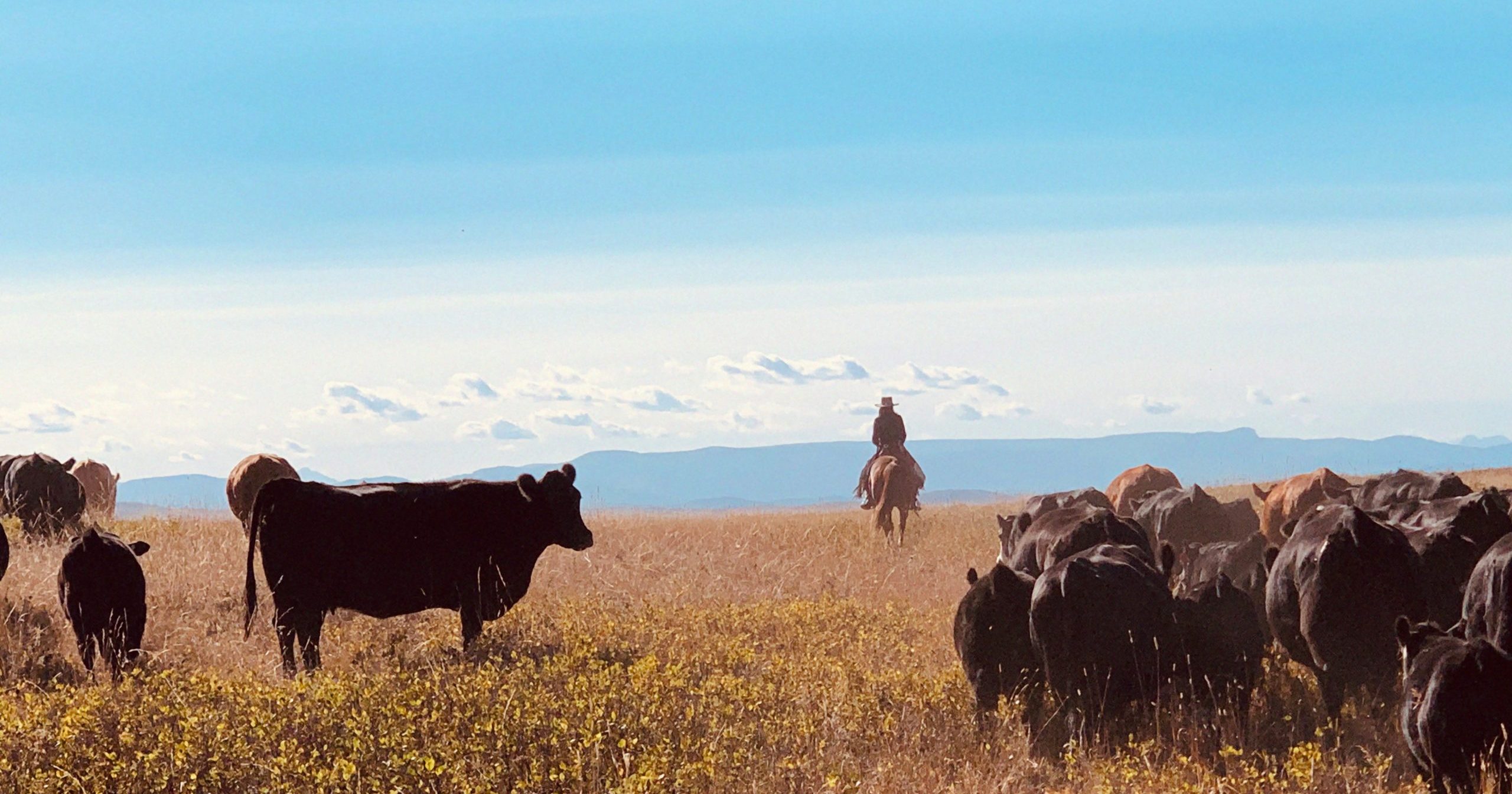AB Direct - Steers
Rail: 495.00-500.00
AB Direct - Heifers
Rail: 495.00-500.00
US Trade- Steers
Rail: 370.00-372.00 (NE/IA) Thursday
US Trade - Heifers
Rail: 370.00-372.00 (NE/IA) Thursday
Canadian Dollar
0.14

Marketing with a focus on health and welfare
As the days of summer fade away and we face the briskness of fall it is time to carefully consider livestock marketing plans for the farm and ranch. Traditionally, this time of year is referred to as ‘the fall run’ as most of the calves, yearlings and cull cows are offered for sale and the next phase of beef production begins.
There are marketing opportunities ahead of and during the fall run to optimize on price, calf health and future beef quality. Long before this time of year, the breeding, vaccination and health program has partially predetermined the value of the calf to the buyer and laid the foundation of the potential of that calf as high-quality beef. Marketing is in the knowing of that value and in seeking out buyers or relationships that pay.
Today, the data that accompanies the feeder calf or yearling are a price determinate. In addition to breed, sex, weight, age, frame size, condition and terms of sale, the information from a validated platform could include genomic and performance history as well a background on feed, antimicrobial use and health information. More importantly, a direct connection or relationship with a feedyard or variety of feedyards or the participation in certified programs present optimal marketing opportunities.
Breaking the pattern of selling late in the fall run is the first consideration for calves, yearlings and cull cows. As volume increases, prices decrease. When the weather turns cold, the nutritional needs of the bovine escalate at a time when grazing is sparse. To keep their growth constant they need to be on better feed in a space in which they are not competing, or they need to be marketed earlier. Early arrivals in the feedyard are also welcome from a contractual, end sales and health perspective. Packers need cull cows in the summer and late summer months.
As Dr. Temple Grandin reminds us, cattle do not have depth perception and are very sensitive to light, movement and sound. Where and how they are handled during gathering, sorting, loading and transport will play out in their stress levels.
The handling and transportation of both feeder calves and yearlings have a direct impact on their future morbidity and mortality. It takes planning. The weather should be seasonally warm and dry and the gathering and sorting done slowly and with care. Feed and water must be provided whenever animals stand for any period of time. Every meal that feeder misses translates into lost gains. Standing for hours and in some cases days, erodes all the benefits of production management. There is a huge difference between a naturally light calf and one that has lost 15% of its body weight (referred to as shrink) through the handling process. A shrunk, hungry calf is also dehydrated, confused and exhausted and has a higher probability of getting sick, especially when it is mixed in with others.
On arrival into the backgrounding lot or feedyard, the cattle will be mixed unless there are enough exceptionally even cattle for a pen lot. It is in the mixing that disease spreads as the calves and yearlings share their germs, although yearlings fair better because they are already weaned. Owning a certified scale on the farm or ranch puts the seller in control of the information regarding the weights and leverages the terms and conditions of sale. More importantly from a health perspective, it reduces stress, standing and extra transport of the cattle. When calves or yearlings for sale vary dramatically in weight or type, then sorting at home and gate loading on the liner might save another mix and sort upon delivery.
Offering weaned calves should preferably take place 45 days or more post-weaning. To market them too early during the stress period only exaggerates their health challenges. This is also costly to the producer as the calves have not had time to regain their weight loss and to be gaining.
As Dr. Temple Grandin reminds us, cattle do not have depth perception and are very sensitive to light, movement and sound. Where and how they are handled during gathering, sorting, loading and transport will play out in their stress levels. Facilities have to be functional and people need to be relaxed and know what they are doing. How cattle are handled at home and after marketing is just as important as the marketing process.
The current marketing systems are based either on the farm, called farm gate sales, or at an auction. Both may be done electronically and buyers can bid remotely. There is no need to physically move weighed cattle or cattle that have been professionally ‘called’ on the farm to sell them. The terms, including the loading date, go into the description of the cattle. Transportation is the responsibility of the buyer. The critical piece in a farm gate sale is that the sale weight, which is the shrunk weight under the terms of sale, matches the weight on delivery.
Keeping the focus on the health and welfare of the calf and yearling is crucial in the marketing process.
In the live auction there are also many options to choose from and this is about matching the cattle to the program. Preconditioned cattle must be just that – with a standard weaning period and health protocol. Pre-sort sales ensure the cattle are sorted into weight and type before entering the ring. Commercial heifer sales also start in the fall with the females selling by the head in owner groups or in pre-sorted lots that are genetically complementary. There are a variety of sales and dates from which to select for feeder cattle and commercial bred females that feature the management on the farm or ranch.
To optimize the market, consider owning a certified scale regardless of your marketing preference. This simple piece of equipment is key to production management benchmarking and marketing. Knowing the strength of the cattle on offer through data collection also opens the gates to a wide variety of validated and certified sales that range from breed type to sustainability practices.
The fall run offers buyers a super selection of genetic diversity in feeder cattle and females and an early selection of breeding stock. For sellers, there are marketing options and best management practices that respect the fragility of calves and young feeder cattle as they navigate weaning, new environments, are transported and must figure out on arrival how they fit in the new social order. For all cattle, during the marketing process and beyond, the reputation of the farm and ranch travels with that animal – right through to the value of the beef. Keeping the focus on the health and welfare of the calf and yearling is crucial in the marketing process and translates into a higher quality beef carcass – and that is the end game.

From progeny to plate
Those great commercial feeder calves and yearlings have a starting point and that is with superior seed-stock. The late fall kick-starts the showcasing of these genetics and bred heifers are the feature. Purebred heifers may be marketed on-farm, on-line or at auction in production sales, female sales or in bred heifer sales. These females, including young replacement heifers and bred cows, are the maternal foundation of the beef industry.
Bull sales, which feature powerful sires for commercial herds, can occur in the current year, usually December, giving commercial producers an early opportunity to tap into genetic diversity and to obtain the sire that is a genetic complement to their herd.
Purebred cattle sell by the head and come as a full data package that includes breed, weight, age and quality characteristics. They are complemented in the sale by their own additional data such as EPDs and/or genomics.
Just as it is with commercial feeders and females, the reputation of the breeder goes with those cattle right out into the field again next spring. From progeny to plate, the chain for producing superior beef starts with the genetics offered by the seed-stock industry and continues with best practices in animal care and welfare.
This article was first published in the September 2021 edition of ABP Magazine. Watch for more digital content from the magazine on ABP Daily.


